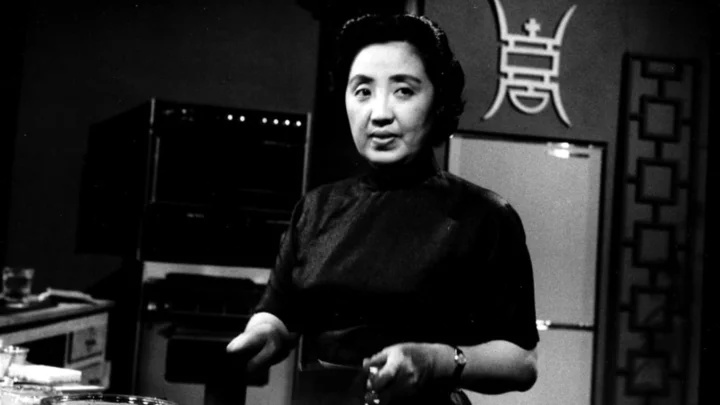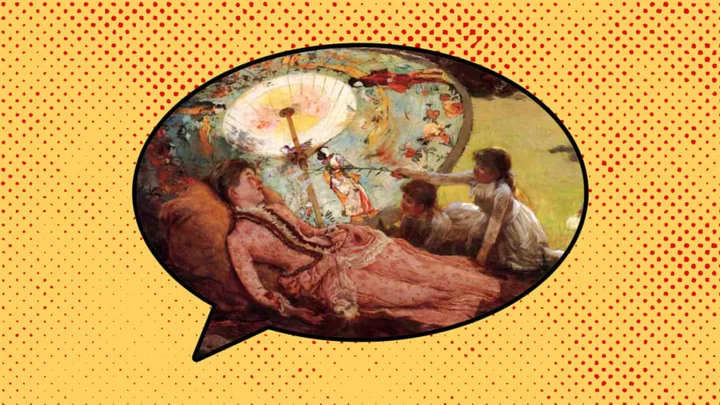
7 Facts About Joyce Chen, the TV Chef Who Introduced Americans to Chinese Cuisine
Through her restaurant, cookbook, and television show, Joyce Chen introduced many Americans to Chinese cuisine.
2023-05-23 00:20

Brains of three suspected zombies scanned in Haiti
Researchers in Haiti once scanned the brains of three people believed to be long-deceased individuals returning from the dead - or zombies. In a study published in 1997, researchers investigated three such cases, using electroencephalography and DNA testing techniques to try and find a rational explanation for a Haitian Voodoo theory that the spirits of the dead can be captured by sorcerers called bokors, who use these souls to reanimate fresh corpses into zombies who walk around rural areas. One case involved a woman who had died aged 30 and was spotted three years later by family members who recognised her because of a distinctive facial mark. A local court then authorised the opening of the woman’s grave, revealing it to be full of rocks. Describing the 'zombie', the study authors explained that “she kept her head in a lowered position, and walked extremely slowly and stiffly, barely moving her arms.” She was also unable to communicate “but would occasionally murmur some incomprehensible but stereotyped words.” But the scan showed her “electroencephalogram and central nervous system examination were unremarkable” and said she may have had catatonic schizophrenia, but couldn't explain how she came back from the dead. Sign up to our free Indy100 weekly newsletter They proposed that the woman might not have died at all, but may instead have been poisoned by a “neuromuscular toxin” to induce catalepsy and trick relatives into thinking she was dead. A lack of oxygen within the grave may have resulted in brain damage, thus explaining her zombie-like state when she was taken out of the grave. Next, the study described a 26-year-old man who was seen at a local cockfight 19 months after being buried. The man’s uncle was subsequently found guilty of using sorcery to zombify the man, who was then kept chained to a log at his parents’ house. But clinical examinations found nothing weird and the man was diagnosed with “organic brain syndrome and epilepsy.” And DNA testing revealed that he was not even the man who had died shortly beforehand. In a similar case, a 31-year-old woman was identified as a villager who had been dead for 13 years. Once again, however, a medical examination revealed that she was a normal human while genetic analyses showed that she was not the dead individual after all. The study authors concluded that “mistaken identification of a wandering, mentally ill, stranger by bereaved relatives is the most likely explanation.” Have your say in our news democracy. Click the upvote icon at the top of the page to help raise this article through the indy100 rankings.
2023-05-23 00:15

Applied Materials to Build $4 Billion R&D Site With US Aid
Applied Materials Inc. is planning to spend as much as $4 billion on a new research-and-development center near
2023-05-22 23:57

Don't delay reforms to prepare for next pandemic -WHO chief
By Emma Farge GENEVA The head of the World Health Organization urged countries on Monday to carry out
2023-05-22 23:28

‘RIP photoshop’: New AI can alter any photo with the click of a mouse
New AI tools that use generative artificial intelligence to manipulate photos have rendered traditional editing tools like PhotoShop obsolete, according to experts. One recently unveiled product called DragGAN allows users to radically alter pictures – from facial expressions to the layout of a landscape – with no prior editing experience. Developed by researchers at Google and the Max Planck Institute of Informatics, DragGAN works through a system that uses multiple points that users can “drag” to create different effects without compromising the image’s realism. “RIP Photoshop,” wrote tech entrepreneur and AI commentator Lorenzo Green. “In just a few clicks, you’ll be able to edit any image exactly the way you want... The applications are endless.” Examples of applications include changing the position of the Sun in the sky, altering the size and setting of a vehicle and editing an animal’s head to change its expression and shape. A research paper detailing the technology explained how the approach can “hallucinate occluded content, like the teeth inside a lion’s mouth”, while also deforming an object’s rigidity, like the bending of a horse’s leg. “Through DragGAN, anyone can deform an image with precise control over where pixels go, thus manipulating the pose, shape, expression, and layout of diverse categories such as animals, cars, humans, landscapes, etc.,” the paper stated. Other features recently launched by generative AI companies include Stability AI’s upscaler that allows users to quadruple the resolution of an image without compromising the sharpness of the original. “Since the emergence of digital imagery, it has been nearly impossible to expand small images into larger ones without compromising the quality of the image,” the company wrote in a recent blog post detailing the advance. “Upscaling adds to popular tools by expanding small images into larger ones while maintaining – or even improving – their level of detail.” While these tools currently go beyond what Adobe’s Photoshop is capable of, the photo editing giant announced earlier this year that it is working on generative AI models. Collectively dubbed Firefly, the next-generation features will allow creators to create images, audio, video, illustrations and 3D models with simple text inputs. “Generative AI is the next evolution of AI-driven creativity and productivity, transforming the conversation between creator and computer into something more natural, intuitive and powerful,” David Wadhwani, president of Adobe’s Digital Media Business, said in March. He added that the tools would help customers by “increasing productivity and creative confidence... from high-end creative professionals to the long tail of the creator economy.” Read More 10 ways AI will change the world – from curing cancer to wiping out humanity WhatsApp will let people change messages after they are sent New Twitter boss says ‘game on’ over Instagram clone rumours Meta hit with record €1.2 billion fine
2023-05-22 23:15

First Arab female astronaut reaches space station
Saudi biomedical scientist Rayyanah Barnawi will carry out breast cancer research while in orbit.
2023-05-22 22:45

Ireland media guide
An overview of the media in Ireland, including links to broadcasters and newspapers.
2023-05-22 22:21

Auliʻi Cravalho won't reprise titular role of Moana in live-action film, but she will help find new star as executive producer
Auliʻi Cravalho
2023-05-22 21:56

What is fezolinetant? The non-hormonal menopause treatment drug explained
The menopause treatment fezolinetant has been predicted as a “gamechanger” by experts for thousands of women who suffer from hot flushes. The drug, which is the first non-hormonal menopause treatment, was recently approved by America’s FDA. Experts are predicting it could be transformative for women for whom hormone replacement drugs (HRT) are not suitable. The drug was licensed in the US on 12 May and could be approved for use in the UK by the end of the year. According to a British Menopause Society survey, 79 per cent of women aged 45 to 65 experienced hot flushes as a result of their menopause transition, while 10 to 20 per cent describe the hot flushes as “near intolerable”. Here’s everything you need to know about fezolinetant: What is it used to treat? It works to target the menopause symptom of hot flushes. The drug that has been approved by the FDA is made by pharmaceutical company Astella, which advises patients to take one 45-milligram of its VEZOAH (fezolinetant) pill orally, once a day. A large clinical trial of fezolinetant published earlier this year revealed that, after 12 weeks of use, it reduced the frequency of hot flushes by about 60 per cent in women with moderate or severe symptoms, in comparison to a 45 per cent reduction in those who received a placebo. Women involved in the trial also said the drug reduced the severity of hot flushes and improved the quality of their sleep. How does it work? It works by blocking a brain protein called neurokinin-3, which plays a unique role in regulating body temperature in menopausal women. Respondents of the trial have said that the effects of the drug was experienced after taking the first tablet. By comparison, HRT, taken to alleviate menopausal symptoms, replaces the oestrogen that you lose during the menopause transition, either alone or in combination with a progestogen What are the side effects? According to the FDA, the most common side effects are abdominal pain, diarrhoea, insomnia, back pain, hot flush and elevated hepatic transaminases. What have experts said about it? “This is going to be a completely blockbuster drug,” said Prof Waljit Dhillo, an endocrinologist at Imperial College London who led a trial for the drug in 2017 toldThe Guardian. “It’s like a switch. Within a day or two the flushes go away. It’s unbelievable how well these drugs work. It’s going to be completely game changing for a lot of women.” Read More Adenomyosis: 5 things you need to know about the ‘evil twin sister’ of endometriosis ‘Suddenly, I saw Dad again’: The radical technology helping those living with dementia Naga Munchetty reveals womb condition adenomyosis: ‘I live every day on painkillers’
2023-05-22 21:29

13 Old-Timey Synonyms for ‘Hot’ to Bring Back This Summer
Why be sweltering and sunburnt when you can be swoly and birsled instead?
2023-05-22 20:17

Adenomyosis: 5 things you need to know about the ‘evil twin sister’ of endometriosis
Despite increasing public awareness of endometriosis, with celebrity figureheads including Lena Dunham and Molly Mae, the condition’s ‘evil twin sister’, adenomyosis, remains neglected. While the NHS has an entire webpage which explains what endometriosis is, there is currently no equivalent for its sister condition. Read on for five things you should know. It’s not the same as endometriosis Both endometriosis and adenomyosis occur when the lining of the uterus (known as the endometrium) grows out of place, but there are major differences between the two. In endometriosis, the rogue tissue invades areas outside of the uterus. While the extent of the growth varies from patient to patient, it can affect areas such as the bladder, bowel, ovaries, and even the lungs. Adenomyosis, on the other hand, causes the rogue tissue to bury inside the muscular wall of the uterus. It’s possible to suffer from both conditions at the same time. Symptoms include bloating, heavy periods, and pelvic pain Thanks to the invasive endometrial growth, adenomyosis is characterised by an enlarged uterus. During menstruation, the embedded tissue swells and bleeds, typically causing a variety of symptoms (although some women are asymptomatic). According to a patient leaflet published by University College Hospital, sufferers commonly have painful and irregular periods, with more than half experiencing heavy bleeding. Chronic pre-menstrual pain, and feelings of heaviness and discomfort in the pelvis are among other possible symptoms. Less frequently, adenomyosis can cause bloating, pain during intercourse, and pain related to bowel movements. All symptoms should stop after the menopause. It affects 1 in 10 women The condition is believed to affect 10 per cent of women in the UK. That makes it just as prevalent as endometriosis, although it’s more common in women between the ages of 40-50, and those who have been pregnant before. While the cause of the condition is not known, UCH says that “genetics and some hormones may play a role”. In terms of long-term effects, the North Bristol NHS trust says that adenomyosis does not appear to decrease the chance of pregnancy, however it has been linked to an increased risk of miscarriage and premature birth. Treatment options are limited For women with mild symptoms, trying to get pregnant, or nearing menopause, the North Bristol trust says that treatment may not be necessary, but for those seeking relief from symptoms, it recommends medication to reduce pain and bleeding, and hormonal interventions such as the contraceptive pill. The only “cure” is a surgical procedure involving the removal of the womb (hysterectomy), although this is a last resort intervention. The Bristol-based trust also offers an alternative surgery which involves blocking the blood supply to the endometrial growth, forcing it to shrink, but neither procedure is advisable for women who want to get pregnant in the future. It can take years to diagnose The condition is typically diagnosed using MRI and ultrasound scans, but the NHS says that adenomyosis can take “a long time, even years, to diagnose” because “symptoms and severity can vary between women”. The frequent dismissal of women’s gynaecological symptoms means that signs of adenomyosis may be conflated with ‘normal’ menstruation, or even other conditions such as endometriosis. Anecdotal reports of sufferers suggest that misdiagnosis is common. Gabrielle Union, one of the only celebrities to have publicly identified as having the condition, suspects her condition went undiagnosed for years. Speaking at a conference in 2019, Union explained: “The gag is I had [adenomyosis] in my early twenties, and instead of someone diagnosing me they were like ‘Oh you have periods that last nine or 10 days and you’re bleeding through overnight pads? Not a mere inconvenience... perhaps there’s something more there.’” Earlier this year, the charity Tommy’s reported that the condition might be “underdiagnosed” after a review of existing studies found that “mild” cases could be missed by clinicians using current diagnostic methods. “There should be training for clinicians and sonographers to diagnose adenomyosis using a standardised criteria,” said Dr Ishita Mishra, leader of the review. “Being able to identify this condition using a uniform set of criteria would then help give us a true picture of the numbers affected, and better understanding of the impact of this condition,” Mishra explained. If you have any health concerns, you should always contact your GP in the first instance. There is also information available via NHS Scotland or Endometriosis UK. Read More Lena Dunham marks five years of sobriety: ‘Happiest of my time on earth’ ‘Some days things just do not work’: What happens when your smear test doesn’t go smoothly? Woman’s warning after terminal cancer mistaken for heavy periods 5 things you need to know about adenomyosis, the ‘evil twin sister’ of endometriosis Woman’s warning after lip filler left her unable to close mouth ‘Suddenly, I saw Dad again’: The radical tech helping those living with dementia
2023-05-22 19:45

Bosnia-Herzegovina media guide
An overview of the media in Bosnia-Herzegovina, including links to broadcasters and newspapers.
2023-05-22 19:24
